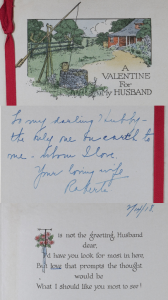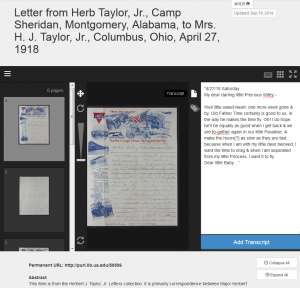By: Ashley Bond, SLIS graduate student
Valentine’s Day is approaching, and in the spirit of romance, Cool at Hoole has taken a look at various love letters within Acumen. The Herbert J. Taylor, Jr. Letters, which includes written correspondence between Major Herbert J. Taylor, Jr. and his fiancée (and later wife) Roberta Dorsey, along with many of his other communications during World War I, is a particularly rich collection.
One very sweet correspondence is the Valentine’s Day card Roberta Dorsey Taylor sent from Columbus, Ohio, to husband Herbert while he was stationed at Camp Sheridan in Montgomery, Alabama, in February 1918:
“To my darling Hubby—the only one on earth to me –whom I love. Your loving wife Roberta”
Here is another letter from April of the same year, this time from Herbert to his wife Roberta while they are still separated by war:
“4/27/18 Saturday
My dear darling little Precious Wifey:-
Well little sweet-heart, one more week gone & by. Old Father Time certainly is good to us, in the way he makes the time fly. Oh! I do hope he’ll be equally as good when I get back & we are to-gether again in our little Paradise, & make the hours[?] as slow as they are fast, because when I am with my little dear beloved, I want the time to drag & when I am separated from my little Princess, I want it to fly.
Dear little Baby…”
Once the United States entered the war in April 1917, congressmen secured three training bases in Alabama. While the merchants in these base cities thrived from having new business customers from around the country, the troops themselves had to cope with being separated from their loved ones for a period of time. Although these letters were likely intended for private consumption originally, the Herbert J. Taylor, Jr. Collection gives readers insight to the passions and hardships endured by a young couple in love during the war. The language style and circumstances have changed, but the story of a long-distance relationship is still relatable today. It is fascinating how affectionately they speak to each other, but perhaps social media, e-mail, and texting have heavily shaped our modern-day ways of speaking.
However, due to the handwritten nature of many of these online documents, certain words and unfamiliar phrases in the letter may be difficult to read to our contemporary eyes. For this reason, University Libraries’ Digital Services allows users to read and transcribe handwritten documents online and submit it for the benefit of future users. Cool at Hoole invites you to take a look at some of the historical documents on Acumen today and even add a transcription or tags on materials you find useful or interesting! Just check out Acumen’s button to the right of each image that says “Transcript.” And, for more details about how to transcribe a written document on Acumen, check out Digital Outreach Coordinator Kate Matheny’s post on this subject the Digital Services blog.


